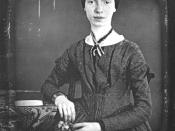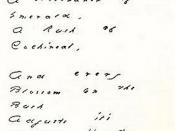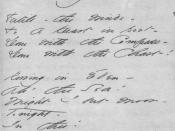Emily Dickinson's poem "I Like to see it lap the Miles-"
ostensibly is a poem depicting two modes of transportation; a
train as characterized by a horse. While this is conclusive
Dickinson also appears to be using the poem to state another mode
of transportation: poetry.
Feelings about poetry are expressed in line three, "And stop
to feed itself at Tanks-", poetry feeds the mind, which feeds the
world. In other words poetry becomes self-generating and in doing
so threatens one's control. Dickinson regains control by passing
through the expected end-stop of line four and illustrates the
form breaking strength of a poetry to "feed itself", and to gaze
with arrogant hatred at the poor "Shanties- by the sides of
Roads-", the pretentious representative world it passes, which,
since it resembles established form, is unable to limit or
threaten it.
Lines nine and ten, "To fit its Ribs And crawl between",
visualizes a shape and this shape belongs to the poem.
Paring a
shape "To fit its Ribs" demands more space and must break normal
stanzaic verse. Dickinson accomplishes this, and, in doing so,
allows the poem to determine its own form. The poem itself
complains and twists this new form "In horrid-hooting stanza-",
but then chases itself, with new self-generation, to escape "down
Hill-".
Dickinson regains control, not that she ever really lost it,
in the last stanza and shows that a poem is always punctual, and
will return one right back to where one began.
To summarize, Dickinson not only gives us a poem depicting a
train as characterized by a horse, she gives us a poem about
poetry. She shows us that although poetry may not necessarily
possess a conventional form, it will emerge a subject, pare its
shape, give us music in the...


